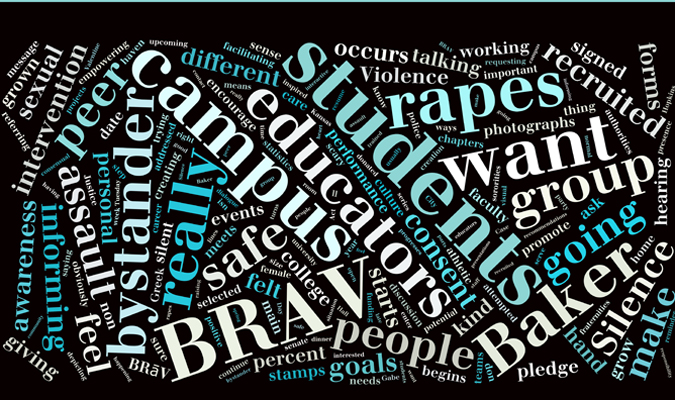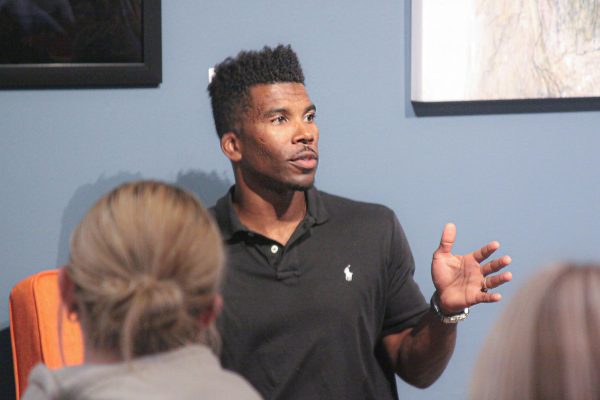BRāV promotes bystander responsibility
“I want to see you be brave.”
Singer Sara Bareilles said it best when it comes to the goal of Baker Rallies Against Violence, or BRāV. The group is working to increase its presence on campus in order to spread that same message concerning sexual assault.
“We have two main goals and those are to encourage bystander intervention,” BRāV co-president Kate Colby said, “and we also want to promote awareness about what sexual assault is and the different forms it can occur in and what to do if you find yourself or someone you care about in that situation.”
Tamara Slankard, BRāV founder and faculty coordinator, started the group in the spring of 2012 because she “felt that there was somewhat of a culture of silence about rape here,” and she wanted to make sure Baker students feel safe on campus. Not only that, but she also wanted students “to feel a sense of personal responsibility in creating and maintaining a safe campus community.”
“The last thing that I would want to happen, A, is that sexual assault occurs at all, and B, that students would feel like Baker was no longer a home for them because of it,” Slankard said.
Fifteen BRāV peer educators who were recruited and hand-selected by Slankard are responsible for conducting educational and informational “No Silence, No Violence” presentations to the Greek chapters and athletic teams on campus.
Senior Liz Jordan said she became a BRāV peer educator because she felt the message the group gives is important and needs to be addressed.
“It’s something that obviously people don’t really want to talk about, which is why we haven’t been talking about it as much as we are trying to now,” Jordan said. “It can be really scary, but it’s also kind of empowering to be the person who is facilitating that discussion and informing people of what’s happening.”
When she says “informing people of what’s happening,” she is referring to the U.S. Department of Justice’s statistics that one in five female college students is raped during her college career, or that less than 5 percent of rapes and attempted rapes are reported to either the police or campus authorities.
Last year, 474 students signed a bystander intervention pledge after hearing the presentations.
“What this means is that if they see a situation where someone isn’t safe or they hear about potential assault or something like that happening, they’ll step in in positive ways,” Colby said. “Basically it’s just saying,’I’m going to do what I know to be right, and I’m going to make the Baker community safe for everyone within it.’”
Since its creation on Baker’s campus, BRāV has grown by 50 percent. Not only has its size grown, but so has its presence on campus, which will continue to grow through upcoming projects and events.
The group is working on requesting funding from student senate for hand stamps to give to the fraternities and sororities for anyone who wants to sign the bystander pledge when they enter a party. The stamps will say “Ask Before You Act” and will serve as a visual reminder of their responsibility as a bystander.
BRāV is also making plans for a silent performance inspired by a series of photographs depicting a date rape, which were donated to the university by Kansas City photographer Gabe Hopkins. As of now, the silent performance is planned during the week of Valentine’s Day.
“It starts off just like any normal date, going to dinner, having a good time, and then it kind of progresses to where it turns into a non-consensual situation,” Colby said. “Our goal with this is to show people where the lines are between consent and non-consenting, and really just open up a dialogue with the Baker community just about what consent is and the different forms it can take.”
The group will resume meetings at the beginning of the spring semester and usually meets at 11 a.m. every other Tuesday in room 300 of Case Hall. Students interested in becoming a member of BRāV can contact Slankard or any other faculty member. Slankard will ask faculty and staff for student recommendations when she begins recruiting peer educators late in the spring semester.
“There are basically two parts to BRāV. There are the peer educators that are recruited and trained, and that’s really the heart of what we do, is going out and giving the interactive ‘No Silence, No Violence’ presentations,” Slankard said. “But then there are other members of BRāV … who work on awareness raising events across campus. That’s the part I really would like to see grow.”







